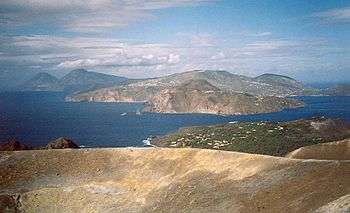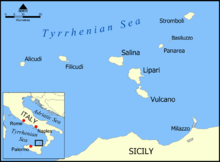Aeolian Islands
The Aeolian islands (Italian: Isole Eolie, Sicilian: Ìsuli Eoli, Greek: Αιολίδες Νήσοι), aka Lipari Islands, are a group of attractive islands in the Tyrrhenian Sea about 25-50 km north of Sicily in Italy. This diverse group of volcanic islands used to be off the beaten track, but it is becoming more popular and can be very busy during July and August. The islands are inscribed in the UNESCO World Heritage List.


Regions

| Lipari the main island and the main town (called Lipari as well) is the transportation hub, with plenty of hotels and makes a good base. |
| Vulcano right next to Lipari, this island is dominated by the Gran Cratere volcano cone giving off clouds of sulphurous gas. This peak gives great views. The island is popular for its beaches and mud baths. |
| Salina lush and hilly - great for a relaxing walk. Some of the film Il Postino was shot here. |
| Panarea a smaller, upmarket island with great views across to Stromboli. |
| Stromboli the most remote of the islands, it is little more than a volcano rising out of the sea. Popular for trips out at night to see lava spurting out of the cone. |
| Filicudi and Alicudi lie to the west and are much less visited, particularly Alicudi, which is still primarily agrarian. |
Cities
Talk
Although local dialects of Sicilian are spoken among the locals, the traveller will find that standard Italian is also spoken by most people. Those involved in the tourist trade may also speak some English, German, or French. Cellular telephone coverage is dependable in the settled areas, but access to the internet is rare. There are a few internet cafes in Lipari Town.
Get in
There are frequent car ferries and much quicker hydrofoils from Milazzo and Messina on Sicily, and from Reggio di Calabria on the mainland, to and between the islands. Most call first at Lipari, and then proceed to the other islands. Ferries are frequent in summer, with fewer during spring, autumn and winter and a reduced service year-round on Sundays. For timetables see SIREMAR, Ustica Lines and NGI. Check the timetables in advance, and allow plenty of time for connections, as boats can be early or late.
A few car ferries a week also continue on to Naples (see SNAV) and during the summer hydrofoils run from Naples, Cefalù, Palermo and Messina.
The Aeolian Islands are quite remote, which is part of their appeal. No air travel is available to the archipelago, except for the very expensive helicopter service which runs during high season from the Catania airport. For more information see Air Panarea or HeliJet. Most international travellers, then, will arrive at the airport of either Palermo or Catania airport in Sicily, or Reggio di Calabria, across the straits of Messina on the mainland.
Although the Reggio airport is relatively near the port, boats from Reggio are infrequent. Likewise, only a few ferries per day run from Palermo during high season, and the airport is far from the city. These ports are best used by the traveller who is already in Italy, as is Naples, a much longer boat trip that is convenient for travelers arriving by plane or train in Naples from points north. For the traveller arriving directly from abroad, numerous budget airlines have routes from around Europe to Catania. From there, one can take the train, or an express bus, to Messina, connecting to a boat; or, at Messina, one can connect to a second train or bus to Milazzo, which has by far the most boat departures. Although it is convenient to change trains in Messina, the Milazzo train station is a few miles from the port. On the other hand, the bus from Catania arrives at the train station, while the bus for Milazzo departs from a separate bus station a few blocks away. Ask for help at the information booth outside the train station. One express bus per day departs from Catania airport for Milazzo, but arrives there so late as to miss the boat for certain of the islands. You may wish to spend the first night in Lipari, with its charming town, and then depart for the outlying islands. As another alternative, the car rental agencies have special deals allowing the traveller the use of a car one-way from Catania to Milazzo - inquire in advance as these deals may not be available without reservations. The car rental agencies in Milazzo are a few blocks from the port. Cars can be left for a few days easily in Milazzo when visiting the islands, just park them in any parking place with blue borders (blue border indicates no parking fee or time limit on parking)
Get around
The larger islands, Lipari, Vulcano and Salina have quite good bus services. Timetables are available at the tourist offices in each island's port. Those islands also have scooters for rent, and are the only of the islands with comprehensive systems of roads. Panarea and Stromboli are small enough to have no roads or automobiles to speak of; Panarea in particular is completely accessible by foot. Alicudi and Filicudi are so remote that they have little in the way of developed tourist industries or infrastructure. On those islands, transport from the port, and scooter rental, should be arranged with one's inkeeper. Boat rental is also popular for touring the periphery of each island; although the small boats for rent are not adequate for travel between the islands, but are popular for the excursion from Panarea to the islets of Basiluzzo and Drauto.
See
Vulcano is the first port of call for ferries from Milazzo. As well as the spectacular view of the narrow channel between this island and neighbouring Lipari, you're also greeted with the strange sight of a stack of sulphurous oozings, right by the harbour, with an accompanying smell! Disembarking, you can follow the road between that stack and a huge red rock, sulphurous fumes hissing out of the side of the pavement, to one of the island's main attractions. Next to the beach, the locals have created a hollow in the volcanic clay that is filled with yellow mud. After bathing in the mud, you can swim in the sea and wash it all off. Swimming here is a very special experience, because the fumaroles extend right out into the sea, bubbling up hot gas and giving the sensation of being in a jacuzzi, in the blue Mediterranean!
The other main attraction on Vulcano is, you guessed it, the volcano! A steep climb from the town, you can walk to the summit of the island for a spectacular view of the other Aeolian Islands. If you have closed footwear, you can traverse the active vents on the north side of the main crater on your way to the top. Here, a great deal of steam and smelly gas is given off, and you can observe large sulphur crystals in the vents. Be careful not to burn your feet on the hot rocks and steam.
Lipari is relatively pedestrian in comparison with exotic Vulcano. Fortunately, it has less exotic prices, and the large main town has a nice old quarter and a decent quota of non-tourist shops. Among the attractions on Lipari is the pumice quarry, reached from the main town by an infrequent bus service. This is right by the sea, and has a nice rocky beach where, interestingly, many of the rocks tend to float off into the sea!
Stromboli is the most spectacular of the islands, as it's the only one that is volcanically active. In fact, it's the only volcano in the world that is known to have been continuously active throughout recorded history. The approach by ferry from Lipari takes one past the sheer sides of the island that rise towards the summit crater, which is permanently shrouded in clouds of its own making. Stromboli town has pretty narrow streets and, further from the centre, beautiful black sand beaches in rocky coves. The must-see attraction is the night-time climb up to the crater. The going is tough (you will be climbing approximately 850 m) but you will see an amazing sunset and the eruptions are incredible. The trip is rounded off by running down the volcanic ash slopes, in the dark!
Do
Most visitors to Vulcano spend time in the mud baths near the port. Entry is inexpensive and free in the low season. You may find it worthwhile to purchase a token for the shower. The water gives you a powerful sulphurous odor which lasts for a few days or even weeks.
About 20 m from the mudbaths there's also volcanic activity out in the sea. The effect is that the water in the sea is literally boiling.